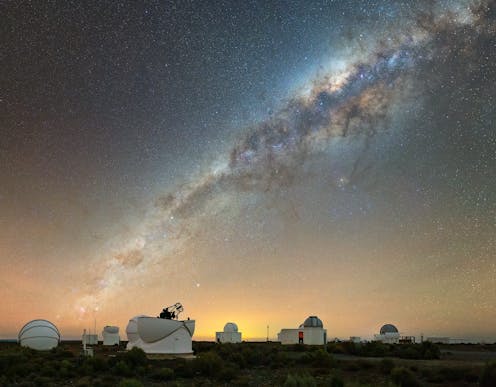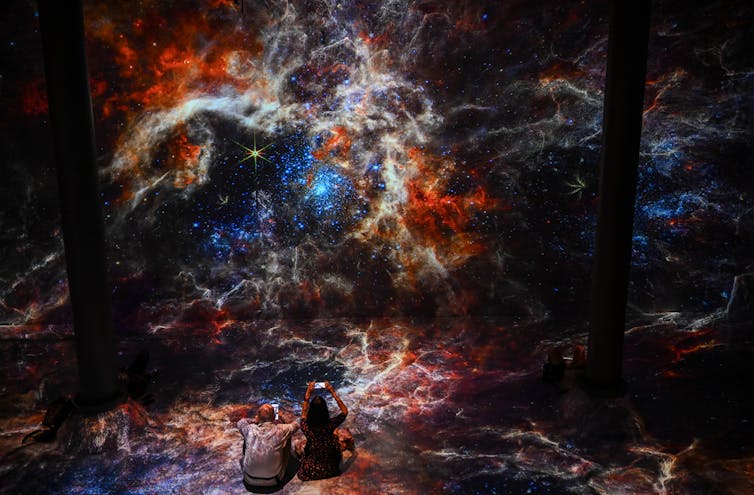
Cutting-edge telescopes, gravitational waves, black holes and our solar system’s central star, the Sun, are just a few of the topics that will be on the table in Cape Town, South Africa, for an event that’s a scientific version of the Olympic Games – though the world’s leading astronomy researchers in attendance will be showcasing their brains rather than their brawn.
The International Astronomical Union (IAU) was established in 1919 and held its first General Assembly in Rome, Italy, in 1922. These assemblies, held every four years, are a chance for the organisation’s members and affiliates to meet in person, and for researchers to share their work with their peers from around the globe.
The 32nd General Assembly, which kicks off on 6 August and concludes nine days later, marks the meeting’s first outing in Africa. This is a significant milestone for the continent; astronomy has grown and strengthened tremendously over the past decade.
This is largely, though not entirely, a result of South Africa’s status as co-host, with Australia, of what will be the world’s largest radio telescope, the Square Kilometre Array (SKA), operated and managed by the Square Kilometre Array Observatory. Its first phase is set for completion in 2027; its precursor, the MeerKAT telescope, is already making huge contributions to both South African and international science. Additional SKA dishes will be located in eight other African countries: Ghana, Zambia, Madagascar, Botswana, Namibia, Kenya, Mauritius and Mozambique.
Read more: MeerKAT: the South African radio telescope that's transformed our understanding of the cosmos
As an astronomer – and the member of the assembly’s national organising committee tasked with coordinating its scientific activities – I am very excited to see this meeting come to the African continent for the first time.
The programme is packed with symposia, focus meetings dedicated to a variety of astronomical subjects, poster presentations and more. Here, I’ve chosen just four of the scientific topics under discussion during the assembly.
1. The James Webb Space Telescope
The astronomy world rejoiced on 25 December 2021 when the James Webb Space Telescope was successfully launched.
Months later the telescope went into testing and verification phases; it is now in full science operations mode and producing discoveries at an astonishing rate. What makes it especially effective is that it offers astronomers the high sensitivity – the ability to detect faint, distant objects – required to study the early universe.

One of the assembly’s symposia, titled “The first chapters of our cosmic history with JWST” features some of the new results in the exploration of the early universe, when the first stars and galaxies were formed.
This is fascinating for astronomers and non-astronomers alike: we’re all interested in knowing whether there’s another planet like ours out there, and the James Webb Space Telescope has already been used to discover many new exoplanets (planets that orbit outside our own solar system). Could any of these planets be habitable for humans? We may have answers sooner than we expected as the telescope continues its remarkable work.
2. The incoming king of radio astronomy
Neutral hydrogen is the most abundant element in the universe and is an essential part of the makeup of galaxies in the universe. When the spin direction of the electron in the hydrogen atom flips, radio emissions are produced. These emissions can be detected by radio telescopes and are crucial for understanding the distribution and kinematics (motion) of gases in galaxies.
MeerKAT, a precursor to the SKA, is already producing groundbreaking neutral hydrogen science because it is currently the most sensitive telescope for neutral hydrogen observations.
Read more: Africa's MeerKAT 'first light' images have blown all expectations
Of course, a project the size and scope of the SKA won’t only be discussed in one or two sessions. An entire focus meeting at the assembly is dedicated to delving into the history of astronomy in South Africa and how it evolved to the point that it was chosen to host the world’s biggest radio astronomy project.
Read more: How visionary scientist Bernie Fanaroff put African astronomy on the map
3. Gravitational waves
It’s been nine years since scientists announced that they had, for the first time ever, detected gravitational waves. This provided clear evidence to support Albert Einstein’s prediction, a century earlier, that gravitational waves existed.
Since that first confirmation a variety of new science has emerged in the field of gravitational wave astrophysics. Astronomers are able to explore our observable universe using not just electromagnetic waves, but gravitational waves – “ripples” in space-time – too. Many of these results will be showcased in a symposium at the general assembly.
4. Our star: the Sun and its massive counterparts
The Sun, the central star of our solar system, is the nearest stellar laboratory available to scientists studying the true nature and environmental impact of solar winds and coronal mass ejections, otherwise referred to as space storms that cause aurora.
Stars of masses eight times or more than that of the Sun are referred to as massive stars. Such high-mass stars evolve faster than their low-mass counterparts. They end their lives in an explosive process, a supernova, and leave behind a fast-spinning neutron star, known as a pulsar.
Read more: In a rare sighting, astronomers observe burst of activity as a massive star forms
One of the focus meetings will concentrate on exploring new results that bridge the gap between massive stars, supernovae and transients from pulsars. Understanding the full evolutionary sequence of massive stars is key to understanding the evolution of galaxies since massive stars influence the chemical composition, structure and morphology of their host galaxy. And a symposium has been dedicated to considering recent advances in solar observations.
Side meetings
The general assembly is also a chance for groups of astronomers to organise side meetings. Some of the science under discussion at these meetings in 2024 includes the Event Horizon Telescope, a global array which is used for black hole imaging, and the African Millimetre Telescope in Namibia. Other meetings will focus on the South African Radio Astronomy Observatory and how to keep night skies dark and quiet for optimal radio astronomy.
James Okwe Chibueze does not work for, consult, own shares in or receive funding from any company or organisation that would benefit from this article, and has disclosed no relevant affiliations beyond their academic appointment.
This article was originally published on The Conversation. Read the original article.







